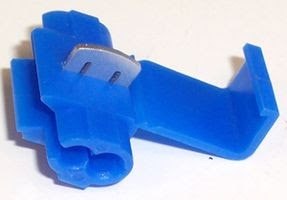
Το ελληνικό άρθρο διαβάστε το » εδώ
The multi-core cables are also connected with pressed terminals to the panel connections.
1) With torsion
2) Electrical Terminal
Made of polypropylene and galvanized steel alloy. Operating temperature: 85 ° C
We find them in cross sections:
or a strange way of turning for the very patient
2) Electrical Terminal
Made of polypropylene and galvanized steel alloy. Operating temperature: 85 ° C
We find them in cross sections:
- 0.75mm2-2.5mm2
- 2.5mm2-4 mm2
- 6mm2
- 10mm2
- 16mm2
- 25mm2
3) CAPS - COVERS (Screws)
The cable covers (CAPS), are made of thermoplastic raw material with internal brass spiral. They are used in cable junctions (cable joints), fast (screwed), providing safety (insulation on the outside) and high conductivity on the inside.
Their application and operating temperatures are from -20 ° C to + 80 ° C.
We find them in cross sections:
Their application and operating temperatures are from -20 ° C to + 80 ° C.
We find them in cross sections:
- 1.5 mm2
- 2.5mm2
- 4 mm2 6mm2
- 10mm2
4) COVERS - COVERS (Pressed)

CAPS fasteners are made of thermoplastic raw material with internal metal conductor. They are used in cable branches (cable connection), fast (pressed), providing safety (insulation externally) and high conductivity internally.
Their application and operating temperatures are from -20 ° C to + 80 ° C.
Available in different sizes depending on the number of cables to be accepted and according to the following table:
Cable joints protection-CAPS 3X2,5mm Cable joints protection-CAPS 4X2,5mm Cable joints protection-CAPS 5X2,5mm
Their application and operating temperatures are from -20 ° C to + 80 ° C.
Available in different sizes depending on the number of cables to be accepted and according to the following table:
Cable joints protection-CAPS 3X2,5mm Cable joints protection-CAPS 4X2,5mm Cable joints protection-CAPS 5X2,5mm
5) Quick splice connector

6) Wago Connectors
7) Soldering iron and tin
The most classic way and at the same time the most 'difficult', if we can characterize it as difficult, is the classic method with the soldering iron and the tin.
The most classic way and at the same time the most 'difficult', if we can characterize it as difficult, is the classic method with the soldering iron and the tin.
Procedure
See another innovative way of gluing pipes
8) BUT SPLICES
Reblog https://oaedhlectrologoi.blogspot.com/2016/12/blog-post_7.html
Strip the cable from its outer casing and then strip the inner cables as needed. Place the cables on the soldering base (if any) for easier gluing. Open the soldering iron and wait 2-3 minutes for it to come to the right temperature. Be careful to stay away from the solder to not inhale the anathymiaseis.Vazoume a thin solder layer in the nose to have better apotelesmata.Topothetoume the soldering iron at the bottom of each cable to fit and solder touching the top meros.Siga slowly starts melt the well and move it along the entire length of the cable, so that the bonding becomes uniform. Insulate each cable separately with insulating tape, and in the end we insulate the cables as a whole. It is good to use insulating tape of different color to know where the cable has a problem so that we do not press it too much there. to make the glue invisible. If we want instead of the classic insulating tape we can use heat-shrinkable spaghetti (a kind of plastic sheath that passes over the cable, which if heated shrinks and closes airtight.)
See another innovative way of gluing pipes
8) BUT SPLICES
Materials
Cable StripperButt SplicesSpecial pliersHot Air Stove (or Power Dryer)
Cable StripperButt SplicesSpecial pliersHot Air Stove (or Power Dryer)
Procedure
Strip the cable from its outer casing and then strip the inner cables as needed. Cut the bare cable to half the length of the inside of the connector.
Put one part on one end and the other part on the other end. Press the connector on the metal part with the special pliers, until the connection becomes stable. With the stove or the hair dryer, heat the connector until it starts to shrink. plastic housing and make an airtight connection. For best results we can pass the cable with insulating tape or with heat-shrinkable spaghetti
Strip the cable from its outer casing and then strip the inner cables as needed. Cut the bare cable to half the length of the inside of the connector.
Put one part on one end and the other part on the other end. Press the connector on the metal part with the special pliers, until the connection becomes stable. With the stove or the hair dryer, heat the connector until it starts to shrink. plastic housing and make an airtight connection. For best results we can pass the cable with insulating tape or with heat-shrinkable spaghetti
In the following video you can watch the overload behavior of some of the above pipe connection materials.
9) Heat shrinkable or heat-shrinkable
To thank the ELECTRICIANS of the 1st EPAS OAED THESSALONIKI for the amazing technological content and the wonderful articles they publish on their blog.






















